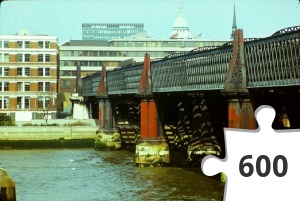SideTracked - Blackfriars
The geocache is not at the published coordinates
Some history:
The station was proposed by the London, Chatham and Dover Railway (LC&DR), who had been given parliamentary power to build a line into the City of London. The company wanted to compete with rivals, the South Eastern Railway, and provide the best service into Central London. The line was complete as far as the Thames by 1864; the LC&DR opened a station called Blackfriars Bridge on 1 June, which sat on the south bank adjacent to Blackfriars Road. An underground station at Blackfriars was opened by the Metropolitan District Railway in 1870, before any mainline stations.
The railway bridge across the Thames was delayed because the City's controlling government, the Corporation of London, were unsure as to what it should look like and how many arches there should be. The station was designed by Joseph Cubitt and had a long roof with walls that stretched up to the riverbank. Cubitt subsequently designed the original bridge, which carried four tracks on a 933 feet (284 m) lattice girder bridge, supported by sets of stone piers supporting iron columns. Services began across the bridge on 21 December 1864. Upon completion, trains ended at a temporary terminal, replaced by Ludgate Hill on 1 June 1865. A further station, Holborn Viaduct, opened on 2 March 1874 and the LC&DR line ran via the Snow Hill tunnel to a connection to the Metropolitan Railway near Farringdon, then on to King's Cross and St Pancras stations.
The mainline Blackfriars station was opened by the LC&DR as St. Paul's railway station on 10 May 1886 when the company opened the St. Paul's Railway Bridge across the Thames. The bridge was constructed parallel to the 1864 Blackfriars Railway Bridge, carrying seven tracks across five arched spans between 175 feet (53 m) and 185 feet (56 m) high. It widened past the bridge to the terminus on the south side of Queen Victoria Street. The original station was a small and cheaply designed pink-red brick building, as the LD&CR had financial difficulties throughout its lifetime attempting to drive a railway through Central London. The station's frontage backed onto the District Railway, making a cab access and forecourt impossible owing to lack of space. It did, however, allow St Paul's a direct interchange with the rest of the underground, unlike all the other LC&DR stations. On 13 November 1886, a direct connection was made between the mainline and underground stations.
After the opening of St. Paul's station, the earlier Blackfriars Bridge station was closed to passengers but remained as a goods station until 1965. Most mainline trains called at St Paul's, including those stopping at Holborn Viaduct. Local commuters continued to use Ludgate Hill where possible, as it was closer to where they were going, but it did not have sufficient capacity.
St. Paul's station was renamed by the Southern Railway as Blackfriars on 1 February 1937. This was partly done to avoid confusion after the London Passenger Transport Board renamed Post Office tube station on the Central line to St Paul's, and partly so that the mainline and underground stations would have the same name. It suffered significant bomb damage during World War II. Overnight on 16–17 April 1941, the signalbox on the south side of the bridge was destroyed, along with a bridge over Southwark Street. The signals were not fully restored until 11 August 1946, after the war.
After the creation of British Railways in 1948, the station was managed by British Railways (Southern Region). Gradually, the structure of the original Blackfriars Railway Bridge deteriorated until it was unsound. In 1961, two tracks were removed from the bridge to ease its load. The station had little investment and still supported some of the original architecture and design up to the 1960s. By this time, services were reduced to a handful of commuter services. The bridge was closed to trains on 27 June 1971 and the deck was removed in 1985, and only the piers in the river and the orange bridge abutments remain.
The station began to be rebuilt along with the Underground station in 1971, which included an additional 150,000 square feet (14,000 m2) of office space. Reconstruction was problematic, as the original station building had sat on top of a cold store, which had frozen the ground below it. The District Line tunnel had to be removed and replaced with a new supporting structure that could accommodate the redesigned station building. The work was formally reopened on 30 November 1977 by the Lord Mayor of London, Peter Vanneck (though the station had never actually closed). A part of the stonework elevation from the 1886 LC&DR station has been preserved at platform level in the main line station indicating many destinations in the south-east of England and in Europe.
Source Wikipedia
The Cache: (stage 1)


About SideTracked Caches
This cache belongs to the SideTracked series. It is not designed to take you to a magical place with a breath taking view. It's a distraction for the weary traveller, but anyone else can go and find it too. More Information can be found at the SideTracked Website
Congratulations to lisboa_bruno on the FTF